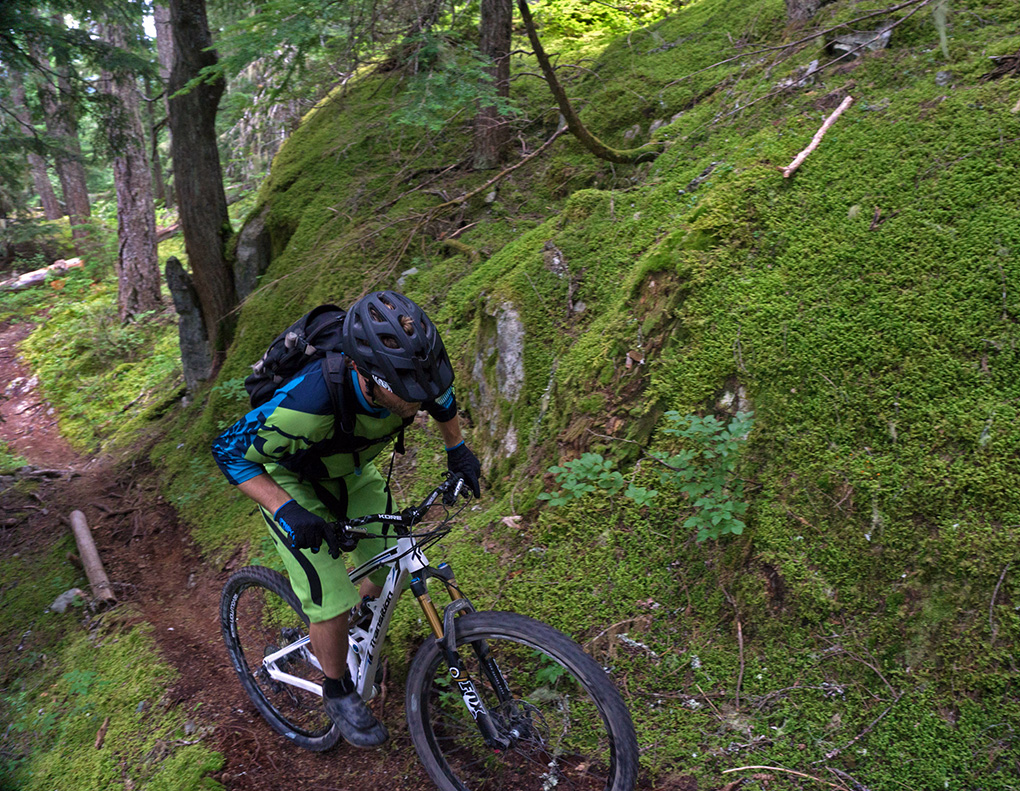Bike: 2014 Transition Covert 29
Size Tested: Medium
MSRP: $3,799
Geometry: (see section below)
Bike Weight (w/ 330g Crank Bros pedals): 32 lbs.
Complete Build: (Here)
Build Overview:
- Drivetrain: Shimano SLX / XT
- Brakes: Shimano SLX
- Fork: Fox 34 140mm CTD
- Shock: Fox Float CTD
Wheels: 29”
Reviewer Info: 5’10″, 165 lbs.
Days Tested: 7
Location Tested: Whistler, BC
Transition has been tweaking the Covert line of enduro / all mountain bikes for the past several years. With the addition of a more slacked-out 29” wheeled option in 2013, the Covert is now available in all three wheel sizes (26”, 27.5”, and 29”) with an aluminum frame. A 26” carbon version is also available.

With the addition of the Covert 29 to Transition’s line, their flagship 29er, the Bandit, was redesigned. The Bandit now has less travel (120mm) and a steeper head angle (69°). With a more pedal-efficient platform and a lighter build, the Bandit caters more to the XC crowd.
But even though the Covert is grouped in Transition’s enduro / all mountain category, every Covert model is billed as being pedal friendly while still excelling on descents. In Transition’s own words: “Our main goal with the Covert was to create a bike that you could ride almost anywhere with the least amount of compromising (…) You can pedal all day and then point it down almost any type of terrain with total confidence.”
Intrigued by Transition’s claims and curious to find out first hand how the 29” Covert performed, we took the bike along on our recent test trip to Whistler, BC.
Geometry
Looking at the numbers, the Covert 29 is a significantly different bike than its smaller-wheeled brethren, largely due to the need to accommodate a larger pair of wheels. It has the shortest top tube and reach of the three bikes, a significantly steeper head angle (68° as compared to 66° on the 27.5” version), chainstays that are nearly an inch longer than the other two bikes, and, surprisingly, the shortest wheelbase of all the models.

Fit & Sizing
According to Transition, the Covert 29 in size Medium (17.5”) is recommended for people 5’6” to 5’11”. That’s a pretty wide range, so if you’re on either end of that spectrum, I would recommend tossing a leg over the next size before you purchase.
I’m 5’10”, and I found the Covert 29 to fit me in a size Medium, but it was fairly tight. I was happy with my position on the bike for climbing fire roads and handling techy, steep descents. While I never felt “in the bike,” I didn’t feel like I was hovering off of it, either—a feeling not uncommon when riding some 29ers given their overall size. I’d use the term “neutral” to describe how the Covert 29 fits and feels when pedaling.

I am, however, curious to try the Covert 29 in a size Large with a short stem to see how the extra room would affect the bike’s fit. The Medium Covert 29 has a 17.5” seat tube, 22.2” top tube and a 15.4” reach, placing it on the shorter and smaller end of the spectrum by today’s standards. The bike’s reach and top tube didn’t feel uncomfortably short when seated, but they were shorter than I prefer. In general, trail bikes are getting longer and slacker these days because of steeper and faster tracks, so you could argue that the Covert 29’s top tube and reach are due for an update.
(A few photos have surfaced recently of Lars Sternberg’s newly redesigned Covert that he is using for the Enduro World Series. The new bike looks long and slack, so maybe Transition is making some adjustments to keep up with current trends. I’m hoping those changes in geometry make it to the 29” version of the Covert, too.)

The Covert 29 has a majorly regressive leverage curve – not surprised it was bottoming out all the time. Very different from the linear design of the smaller wheeled versions. Afraid volume spacers may not do the trick – just too regressive.
Anywhere I can see a graph of that curve? or know what the ideal shock for it might be?